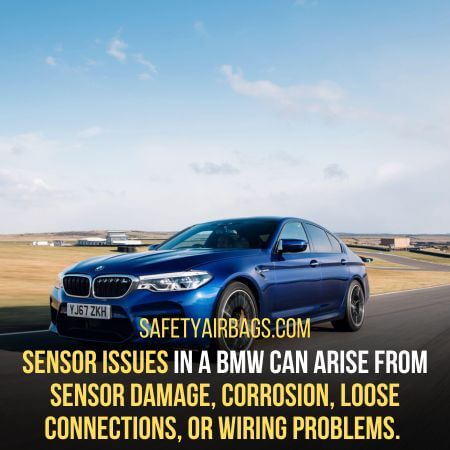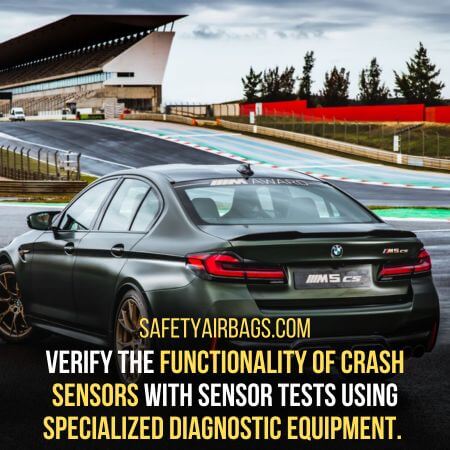Why is my BMW airbag light On? When the airbag light in a BMW illuminates, prompt attention is necessary to ensure the safety of occupants.
What Will I learn
- 1 Bmw Airbag Light On – What Are The Causes?
- 2 Diagnostic Procedures
- 3 Resolving Airbag Light Issues In BMW
- 4 Importance Of Airbags In BMW
- 5 Conclusion:
It is crucial not to ignore the warning and to seek professional assistance to address the problem effectively.
Bmw Airbag Light On – What Are The Causes?
The activation of the airbag light in a BMW can be attributed to various causes.
1. Faulty Sensors And Sensor Connections:
Faulty sensors can lead to improper detection of collisions or impacts, resulting in delayed or failed deployment of the airbags during an accident.
This can significantly compromise occupant safety.
2. Potential Causes Of Sensor Issues In BMW:
Sensor issues in a BMW can arise from sensor damage, corrosion, loose connections, or wiring problems.

Environmental factors, normal wear, and tear, or manufacturing defects can contribute to sensor malfunctions.
3. Defective Airbag Control Module:
The airbag control module is crucial in continuously monitoring the sensor signals and determining when to deploy the airbags.
If the control module fails or malfunctions, it may not properly interpret the sensor data or send the deployment signals, activating the airbag light.
Possible Reasons For Control Module Failure In BMW:
Control module failure in a BMW can occur due to the following:
– Electrical faults
– Software glitches
– Component aging
– Damage caused by water intrusion or physical impact
– Environmental factors
– Manufacturing defects can contribute to control module issues.
4. Wiring And Electrical Issues:
Faulty or damaged wiring within the airbag system can disrupt the flow of electrical signals and compromise the proper functioning of the airbags.
Wiring issues can prevent the sensors from communicating with the control module or hinder the deployment mechanism, leading to airbag light activation.
Wiring-related causes include wire corrosion, fraying, short circuits, or loose connections.
These issues can result from vehicle vibrations, exposure to moisture or extreme temperatures, improper installation, or damage caused by accidents.
By understanding the causes of airbag light activation in a BMW, owners can better identify and address the underlying issues to restore the functionality of the airbag system.
Diagnostic Procedures
A systematic diagnostic approach is necessary to identify and resolve airbag light issues in a BMW.
1. Initial Visual Inspection And Physical Checks:
When faced with an illuminated airbag light in a BMW, the following visual inspection and physical checks should be conducted:
Observe the airbag light on the instrument cluster. Note whether it illuminates consistently or intermittently and whether it remains on or flashes.
Inspect the physical connections of the airbag system components, including sensors, control modules, and wiring harnesses.
Look for loose connections, damaged wires, or signs of corrosion. Ensure that all connections are securely attached.
2. Scanning For Diagnostic Trouble Codes (DTCs):
Scanning for DTCs helps to identify specific issues within the airbag system. Follow these steps:
Connect an OBD-II scanner to the vehicle’s onboard diagnostic port. Access the airbag system module and retrieve any stored DTCs. Make a note of the codes for further analysis.
Refer to the BMW-specific diagnostic code manual or consult a professional for assistance in interpreting the retrieved DTCs.
Identify the codes’ specific issues, such as sensor malfunctions, control module faults, or wiring problems.
3. Performing Additional Tests And Checks:
In addition to scanning for DTCs, the following tests and checks should be performed:
Verify the functionality of the crash sensors by conducting sensor tests using specialized diagnostic equipment.
Check the sensor connections for proper attachment and signs of damage or corrosion.

Perform module tests to assess the functioning of the airbag control module. Ensure that it can communicate with other components and respond appropriately to signals.
If necessary, consult the vehicle’s service manual for specific testing procedures.
Thoroughly inspect the wiring harnesses for damage, such as frayed wires, exposed insulation, or signs of wear.
Perform continuity tests and voltage checks to identify electrical issues within the wiring harnesses.
Resolving Airbag Light Issues In BMW
Once the diagnostic procedures have been completed, appropriate actions can be taken to resolve the airbag light issues in a BMW.
1. Addressing Sensor and Connection Problems:
If faulty sensors are identified, they should be replaced with OEM or high-quality replacements.
Ensure that all sensor connections are secure and free from corrosion. Perform calibrations as required after sensor replacement.
After sensor or connection repairs, it is essential to perform calibration procedures using manufacturer-approved diagnostic equipment.
This ensures that the sensors and control module are synchronized and operating correctly.
2. Repairing Or Replacing The Airbag Control Module
In some cases, the airbag control module may be repairable.
Consult a specialized repair service or an authorized BMW dealership to determine the feasibility of repairs.
Repair procedures, if available, should be followed strictly.
Replacement options should be considered if the control module is beyond repair or if repairs are not recommended.
Obtain a compatible replacement module from a reputable source and follow the manufacturer’s instructions for installation and programming.
3. Fixing Wiring and Electrical Issues:
Carefully inspect the wiring harnesses for any identified issues during the diagnostic process.
Repair or replace damaged wiring as needed, wire routing, and attachment.
Check the grounding points and ensure they are clean and securely fastened.

Verify the integrity of electrical connections within the airbag system, including connectors, terminals, and fuses.
Clean or replace components as necessary to ensure reliable electrical connections.
By following these diagnostic procedures and appropriately addressing the identified issues, BMW owners can resolve airbag light problems.
It is important to prioritize safety and, if needed, consult qualified professionals or authorized BMW service centers for expert assistance.
Importance Of Airbags In BMW
The airbag system in a BMW plays a crucial role in protecting occupants during a collision by providing an additional layer of safety.
It helps to reduce the risk of severe injuries by cushioning the impact and preventing occupants from striking hard surfaces within the vehicle.
Airbag System Components:
The airbag system in a BMW consists of several key components that work together to ensure occupant safety:
1. Airbag Control Unit (ACU):
The Airbag Control Unit is a crucial component of the airbag system in BMW vehicles.
It acts as the central processing unit for the entire system.
It receives data from various sensors and determines when and where to deploy the airbags in the event of a collision.
2. Crash Sensors:
BMW vehicles are equipped with multiple crash sensors strategically placed throughout the vehicle.
These sensors detect sudden deceleration or changes in vehicle motion, indicating a potential collision.
They send signals to the Airbag Control Unit to initiate the deployment sequence.
3. Airbag Modules:
The airbag modules are the actual airbags that inflate in the event of a crash.

BMW vehicles typically have multiple airbag modules placed at various locations, including the driver’s side, passenger’s side, and side curtains.
Each module consists of a folded airbag and an inflator system.
3.1 Driver’s Airbag:
The driver’s airbag is located in the steering wheel hub.
It is designed to protect the driver’s head and chest in a frontal collision.
3.2 Passenger Airbag:
The passenger airbag is usually located in the dashboard and is designed to protect the front passenger’s head and chest during a frontal collision.
Some BMW models also feature advanced sensors that can detect the presence and weight of a passenger to optimize airbag deployment.
3.3 Side Airbags:
Side airbags are positioned on the sides of the front seats or the door panels.
They deploy to protect the occupants’ torsos and pelvis in case of a side impact.
3.4 Side Curtain Airbags:
Side curtain airbags are typically in the roof lining above the side windows.
They deploy in a side collision to protect the occupants’ heads and can cover the entire window area.
4. Seat Belt Pretensioners:
BMW’s airbag system includes seat belt pretensioners, designed to remove slack from the seat belts during a collision.
They retract the seat belts to minimize occupant movement and enhance the effectiveness of the airbags.
Airbag Deployment Mechanism:
The airbag deployment mechanism includes pyrotechnic devices, such as squibs or inflators, and fabric airbags.
When the airbag control module signals for deployment, the inflators rapidly inflate the airbags within milliseconds.
This cushioning barrier helps protect occupants from contacting hard surfaces within the vehicle.
Purpose Of Airbags In Ensuring Occupant Safety:
The primary purpose of airbags in a BMW is to reduce the risk of severe injuries to vehicle occupants during a collision.
When deployed, airbags serve as a supplemental restraint system to the seat belts, providing additional protection.
They help cushion the impact and prevent occupants from striking the vehicle’s interior components, such as the steering wheel, dashboard, or side panels.
Significance Of The Airbag Light As A Warning Indicator:
The airbag light in a BMW serves as a crucial warning indicator.
When the airbag system detects a fault or malfunction, it triggers the illumination of the airbag light on the instrument cluster.
The presence of an illuminated airbag light indicates that there may be an issue within the airbag system that requires attention.
It is essential not to ignore this warning and to address the problem promptly to ensure the proper functioning of the airbag system and the overall safety of the vehicle occupants.
Conclusion:
The airbag system in BMW vehicles is an essential safety feature to protect occupants during collisions.
Understanding the components of the airbag system, the purpose of airbags, and the significance of the airbag light is vital for maintaining occupant safety.
Various factors, such as faulty sensors, a defective control module, or wiring issues, can activate the airbag light.
By following proper diagnostic procedures and addressing the underlying causes, BMW owners can ensure the effective functioning of the airbag system.
